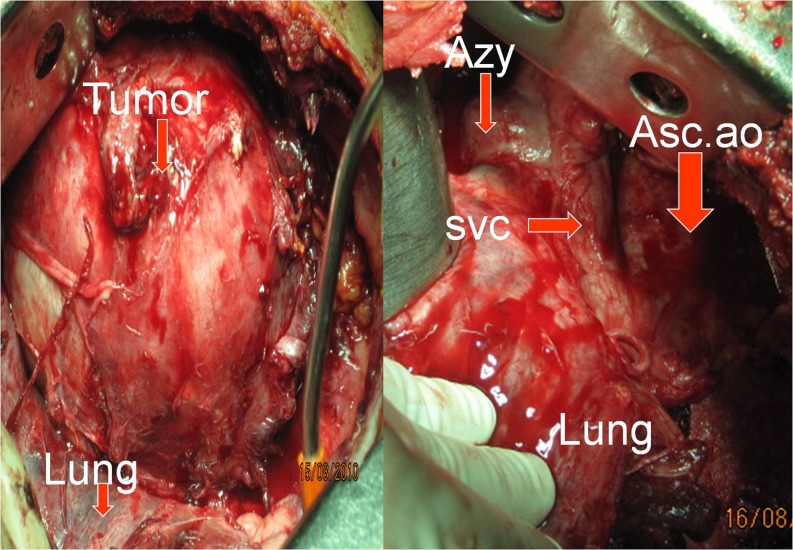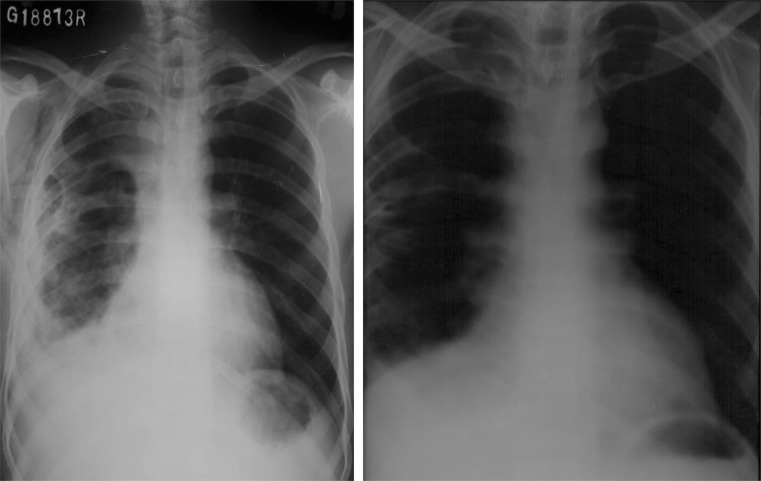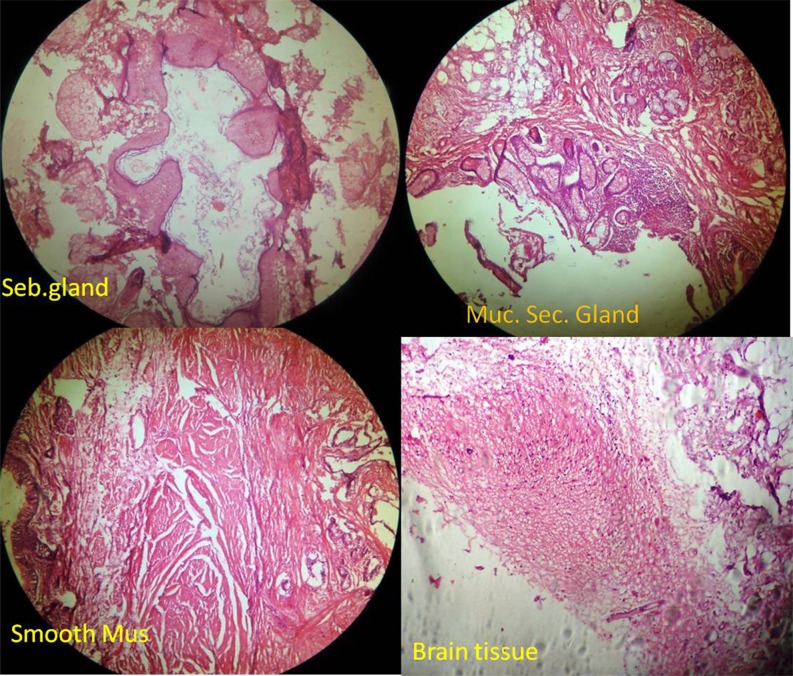Abstract
Anterior mediastinal teratomas are rare germ cell tumors. We report a case of such rare tumor in a young adult male of 21 yrs old who presented with persistent cough of one and half month duration. Computed tomography of the chest confirmed the diagnosis as anterior mediastinal teratoma. Patient underwent a right anterolateral thoracotomy. Intraoperatively there was a large mass in the anterior mediastinum extending to right hemithorax. The mass was compressing the great vessels, adherent to chest wall, pericardium, and lung. Complete excision of the mass done. Patient underwent uneventful recovery. Histopathology reported as benign cystic teratoma.
Keywords: Mediastinal Teratoma, Extra-gonadal germ cell tumor
Introduction
Germ cell tumors are predominantly found in the gonads, and the most common extragonadal site is the anterior mediastinum [1]. Mediastinal germ cell tumors account for 15 % of all mediastinal tumors in adults and 24 % in children [2]. Of the tumors of the anterior mediastinum, benign cystic teratomas have excellent prognosis after complete surgical excision.
Case Report
A 21-year-old male patient presented with history of persistent productive cough and dyspnea for 1.5-month duration. Physical examination showed decreased air entry on the right side in infraclavicular, mammary, and infra-axillary areas. Chest X-ray (Fig. 1) showed a mediastinal mass and collapse of the right lung. CT scan of chest (Fig. 2) showed a large heterogeneous soft-tissue dense mass of 13.6 cm × 11.1 cm in the anterior mediastinum extending to right hemithorax with areas of fat and calcification within the lesion. The mass was compressing the cardia and great vessels of the mediastinum and the right middle and lower lobe bronchi; mild atelectasis of the right middle lobe was noted. Fat planes with pericardium were obliterated. USG-guided fine-needle aspiration cytology revealed a benign cystic teratoma. Testicular ultrasonography showed both the testes to be normal. The patient was planned for complete resection. He underwent a right anterolateral thoracotomy through the 5th intercostal space. Intraoperatively a large mass of 12 cm × 10 cm × 8 cm present in right hemithorax, anterior to hilum of the right lung (Fig. 3). Mass, was adherent anteriorly to the chest wall, medially to pericardial fat, and inferiorly and posteriorly to the lung tissue. With careful blunt and sharp dissection, the mass was dissected all around and was resected completely without injuring any vital structures. Apical and basal thoracostomy tubes were placed and wound was closed in layers. Post-excision lung expansion was 80 % intraoperatively. Postoperative period was uneventful. Serial postoperative X-rays showed good right lung expansion (Fig. 4). Grossly cut section showed pultaceous material, hairs, cartilage, bone and teeth (Fig. 5). Microscopy revealed a mature teratoma with cystic structures lined by stratified squamous epithelium and at places cartilage, bone, respiratory epithelium, mucous secreting glands, adipose tissue, and brain tissue (Fig. 6)
Fig. 1.

Pre-op chest x-ray
Fig. 2.
CT-chest
Fig. 3.
Operative Photograph
Fig. 4.
Post-operative follow-up chest x-ray day-5 and day-15
Fig. 5.
Cut section of the specimen
Fig. 6.
Microscopic picture
Discussion
Germ cell tumors are uncommon neoplasms that usually arise in the gonads. The most common extragonadal site is anterior mediastinum. It is estimated that only 1–3 % of all germ cell tumors arise in the mediastinum [1]. Germ cell tumors account for 15 % of adult anterior mediastinal tumors and 24 % of all pediatric anterior mediastinal tumors. Teratomas are equally present in men and women with an age range from 1 to 73 years, and average age at presentation is 28 years. There is now general acceptance that extragonadal germ cell tumors represent malignant transformation of germ cell elements within these sites without a gonadal primary focus. A theory to account for extragonadal germ cell tumors was proposed by Fine [3], who suggested that there was an error in migration of primitive germ cells along the urogenital ridge. Histologically mediastinal germ cell tumors are classified as teratomas which may be mature or immature, teratoma with malignant elements, teratocarcinoma, seminoma, and nonseminomatous tumors.
Benign teratomas are often asymptomatic and are discovered on chest radiograph obtained for unrelated reasons. If symptoms are present, they are due to mass effect and may cause cough, dyspnea, or chest pain. Teratomas may rarely cause superior vena cava syndrome. Rarely the patient may have expectoration of hair (trichoptysis) and is pathognomonic symptom. CT with IV contrast is the imaging modality of choice with a suspected germ cell tumor. Benign teratomas are usually rounded with sharp margins. They often contain variable amount of fat, soft tissue density, cystic areas, calcification, and bone or teeth. A fat fluid level may be seen in cystic teratomas.
Complete resection is curative for a benign teratoma, and there is no role for adjuvant chemotherapy or radiotherapy [4].
Conclusion
Even though anterior mediastinal teratomas are uncommon tumors, complete excision of the tumor without any surgical complication is possible in most of the cases. Hence, these tumors can be cured by surgical excision.
References
- 1.Nichols CR. Mediastinal germ cell tumors: clinical features and biologic correlates. Chest. 1991;99:472. doi: 10.1378/chest.99.2.472. [DOI] [PubMed] [Google Scholar]
- 2.Mulen B, Richardson JD. Primary anterior mediastinal tumors in children and adults. Ann Thorac Surg. 1986;42:338. doi: 10.1016/S0003-4975(10)62751-8. [DOI] [PubMed] [Google Scholar]
- 3.Fine F, Smith RW, Jr, Pachter MR. Primary extragenital choriocarcinoma in the male subject. Case report and review of literature. Am J Med. 1962;32:776. doi: 10.1016/0002-9343(62)90167-5. [DOI] [PubMed] [Google Scholar]
- 4.Saabye J, Elbrik A, Anderson K. Teratomas of the anterior mediastinum. Scand J Thorac Cardiovasc Surg. 1987;21:271. doi: 10.3109/14017438709106037. [DOI] [PubMed] [Google Scholar]







